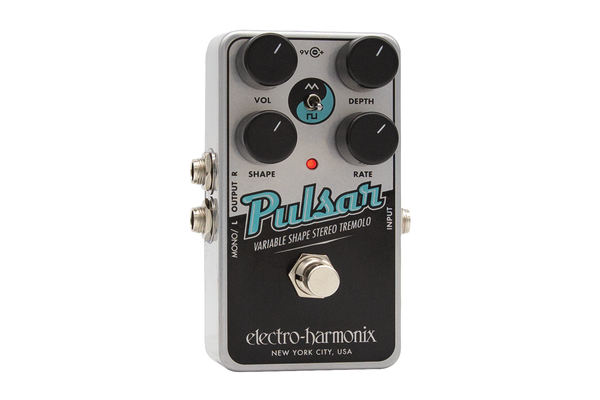I loved the first few iterations of the EHX Pulsar tremolo—particularly the stereo version that appeared in the early 2000s. Two decades ago, there weren’t that many pedal-tremolo options. But the Pulsar didn’t just stand out for lack of competition. I thought it sounded ace and not a million light years away from the optical tremolo in the black-panel Tremolux that I used most at the time. If it didn’t quite nail the sound of real amp tremolo, it sounded mighty fine in a band context and with other effects. And the fact that the tremolo on the old Tremolux worked as irregularly as it did meant I got pretty well acquainted with the Pulsar. I came to love the way it sounded, its name, and the way it looked hooked up with my Big Muff and Small Stone. (Note to self: Revisit that chain at the earliest possible opportunity!)
The new Nano Pulsar is the latest old-guard EHX pedal to receive the shrink-ray treatment. And while I miss the look of that big enclosure, the Nano’s small size and volume control arguably make it a pedal of much greater utility.
Mass Reduction Plan
Over the years, original Pulsars (along with quite a few other pedal tremolos) have been criticized—unfairly in most cases—for what users perceive as volume loss. I never experienced the phenomenon in my own 2000s Pulsar. But to make sure they don’t hear any such beefs going forward, EHX has included an output-volume control that ensures users don’t mistake the volume attenuation intrinsic to tremolo as signal loss. The amount of available extra volume isn’t huge, but it’s considerable. And if you set your tube amp at the verge of its distortion threshold, it’s enough the make the amp perceptibly dirtier. There’s a lot of range for reducing the output volume of the tremolo’d signal as well. That may not sound very useful at first, but as I checked out these volume-attenuated settings, a little ditty based on tremolo’d quiet verses and un-effected louder choruses practically wrote itself. No matter how you use the volume effect, it definitely extends the dynamic potential of the Nano Pulsar.
As I checked out these volume-attenuated settings, a little ditty based on tremolo’d quiet verses and un-effected louder choruses practically wrote itself.
Rock Throbster
The controls elsewhere are pretty sensitive, which means it can be hard to dial in a just-right depth or rate setting at times (this will almost certainly stoke the ire of tap-tempo addicts—there is no such option here). But though it’s trickier to find given depth and rate recipes on the Pulsar than it is on the Fender Vibrolux I used for comparison, practice made perfect. After a few go-rounds with the Nano Pulsar, I was able to intuitively find the settings I wanted or used regularly. Remember, too, that some of the sensitivity in the rate and depth controls is attributable to their greater range. There are things you can do with the Nano Pulsar that you can’t do with amplifier tremolo. The rate control, for instance, ranges from a preposterously slow 20-seconds-per-cycle (which sounds super cool with amp feedback) to super-fast sounds that sound like ring-modulated robot gibberish.
The depth control, too, is much quirkier than the depth control on an amp. Much of its lower range generates pulses that verge on imperceptible. And the most traditional sounds generally reside within the 10 o’clock to 1 o’clock range. Beyond that point, the pulses modulate between positive and negative phase, which gives the waveforms a twitchier personality. To my ear, these sounds are especially effective at advanced rate settings, which highlight the hanging-in-the-flying-saucer-engine-room sensations you can produce here. They are even cooler when you work the wave-shape knob, which shifts the wave peak from center to form asymmetric rise and fall rates. As with many facets of the Pulsar’s performance envelope, finding the wave shape that precisely suits your needs and musical vision might take patience, but the search can yield bountiful surprises.
The Verdict
Though I’m pretty familiar with the quirks of the old Pulsar, the Nano reminded me that the controls can feel pretty unconventional compared to amp tremolo controls or those on more straight-ahead tremolo pedals. That shouldn’t be a deterrent to exploring what the Pulsar has to offer though. The trad sounds are rich and satisfying, while the weirder fare is fun, sparks musical ideas, and can be utilized in subtle or freaky and intense settings. The simple stereo capabilities yield big payoffs when you introduce a second amp, and even if this isn’t a practical move in performance, it’s a blast to use in recording situations. At just a click more than 100 bucks, it’s a very inexpensive way to enrich your library of modulated tones in a big way.















